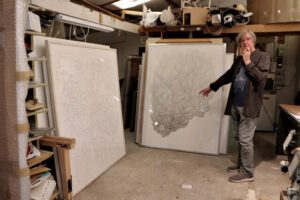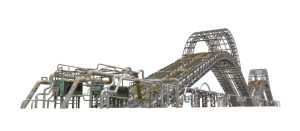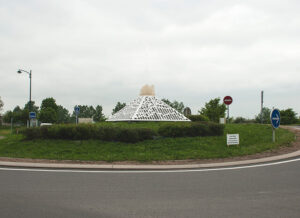About towers
par Joe Neill
Towers have existed since a very long time. A tower has always fulfilled the desire of humans to rise up physically from their normal level on Earth to be in a higher place. Towers are static, in general they do not move from place to place, although some
examples of this type tower can be found in the history of building.
Towers exist and have existed in forms different from how we know them best. For example, a tree, it is a form of a tower constructed by Nature and presenting almost all of the characteristics of a modern tower. That is, height, levels, means of ascending, possibilities of moving away from the center, means for observing, possibilities to be hidden and even the availability of nourishment. A type of tower that is much more dominating and perhaps less practical is a mountain or a hill. These two could be more useful than the aforementioned example but are less local yet sometimes more stategic. Trees and mountains are Natures way of creating an observation point, a way of communing with the sky, a means of isolating oneself from the rest of the world, as in an “Ivory Tower” that is a place to reflect and ponder life as an observer and not as a participant and a way to communicate intensely with Nature.
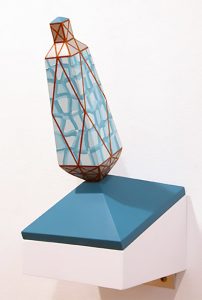
Sculpture bois peint 35x14x14cm
Towers are also constructed by humans in order to fulfill many of the same purposes as described above and even more. A tower is a dwelling, but not always. It can be a city. It can be just a place like a pile of stones in order to see someting better or to keep your feet dry when crossing a stream. A tower is not a wall. A wall accomplishes some of the previous tasks but lacks the primary characteristic of a towers singular form which is compact, linear and always fleeting toward the heavens. It’s form is a kind of gesture of energy. Like Brancusi’s “Bird in Flight”, a tower makes you feel you are rising up just by looking at it, even before using its verticality to accomplish the task of vertical displacement.
A tower makes you want to rise up even if you do not want to. It creates the desire to see the world below differently. It permits
an intense feeling of vertigo, pleasant or not, one feels a wind that is not the same as the one close to the ground and it
allows us to get closer to the space that surrounds the Earth.
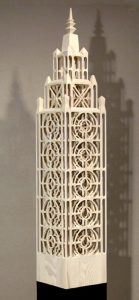
Sculpture bois peint 154xx33x33cm
Small towers, built by humans, existed early on for the practical purposes of seeing better and for defensive reasons. Bell towers were for communicating. Calling people to worship and for organizing the day. The tower was a kind of clock. People knew when the work day started and ended thanks to a bell tower that announced the hour. The bell was also for defense, telling people to head for shelter if danger was approaching. Towers were used for scientific studies of the sky and Earth.We all know about Galileo’s experiments from the Tower of Pisa that proved gravity kept us on the Earth. Curiously, at that time towers were also our only means to get off the earths surface. Towers are monuments as well. The Egyptians used the obelisque and the Romans giant columns to commemorate events and victories. Towers were also war machines. The Greeks built towers to attack fortified cities. The were literal moving buildings carrying men and materials high enough above ground so as to be on the same level as the city walls. But towers were also peaceful. Water towers to supply homes with water under pressure. Television and radio towers for communication and light towers for aircraft signals. Not to mention towers that have existed for centuries for guiding boats. Better known as lighthouses. These towers are both practical and mystical at the same time. Do they not provide for an eye in the storm and in the night for ocean travelers ? There are also towers for transporting electricity. Perhaps the most impressive of all the towers are the skyscrapers that we live and work in, in cities around the world. It is no mistake to refer to high buildings as skyscrapers. This word reflects the mythical and dreamlike status that these fabulous structures represent for our modern age. In the 21st century we have built technically impressive buildings but we are not the only ones to have exploited the technology of the period to create tall structures. Think of Babel, a tower only to be destroyed because man wanted to be too close to God. The Lighthouse of Alexandria is a mythical construction like Babel that continues to make us dream of human exploits of a far away time very different from our own. There are the structures of Paolo Soleri that were conceived to use less ground space but at the same time incorporating all the necessary elements of a modern city. His builings were never built but in Chicago the John Hancock Center comes very close to the same concept where people live and work in the same verticle space and theoretically never have to leave to carry on their life. Lastly, as a sad example the World Trade Center in New York destroyed because it was both functional and symbolic. It too incorporated activities that were diverse in a vertical space, brushing the sky and literally moving in the winds that swirled around them each day of their short life. These structures are a little like us, they stand out and are alone. They are set apart from everything that is horizontal on the Earth creating a kind of spiked ball hurtling through space. Towers have served many purposes in the span of Human existence. They are symbols or our technological powers while reducing to a minimum the footprint of man kind on the Earth’s surface yet including all that is necessary for contemporary life. In spite of the fact that airplanes exist to take us even higher and faster, a tower still fulfills our continuing wish to experience the space above our heads as well as the land under our feet by giving us the time to more easily contemplate the world. A tower lives, moves and breathes. It is almost human, it is not pithicanthropus erectus but it is not far from the same principal.

Sculpture bois et carton stabilisé 242x120x120cm
So, why build towers as sculptures ? A tower is a kind of monument to progress and human society. Admittedly, a tower is somewhat an ego trip but it is still a gesture of hope and it is not just a symbol of capitalist power but a kind of American cathedral without the religious content. Especially today, where most kinds of hope are directed toward a material goal and less toward a spiritual or collective concern for those around us. It is also represents a structural and organisational problem similar to our social system. It is not surprising that Tatlin used a tower as the form for his “Monument to the 3rd International” which was an expression of the energy and hope for a new and better world. In that same tradition my towers are a wish that the world will be able to continue to grow and evolve in a positive and constructive way that will benefit all of us. A tower stands up to be noticed and in its way is a microcosme of many aspects of society both spiritual and practical. Thus, it represents me and my desire to show a positive path in this contemporary world that seems to have difficulty understanding which directions to chose and for what reasons we exist, while never forgeting that the world is rebuilt every morning.
Joe Neill – Paris – 2004



